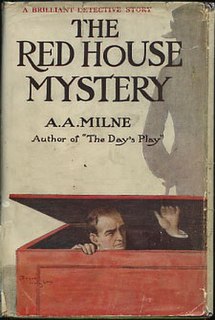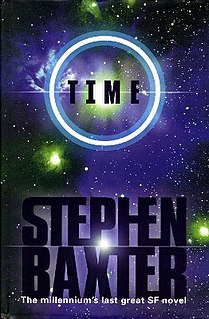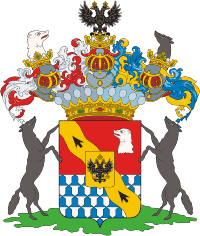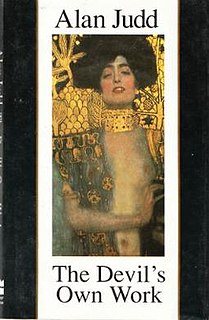
Ivan IV Vasilyevich, commonly known in English as Ivan the Terrible, was the grand prince of Moscow from 1533 to 1547 and the first Tsar of all Russia from 1547 to 1584.

The Red House Mystery is a "locked room" whodunnit by A. A. Milne, published in 1922. It was Milne's only mystery novel.

The Black Arrow: A Tale of the Two Roses is an 1888 novel by Robert Louis Stevenson. It is both a historical adventure novel and a romance novel. It first appeared as a serial in 1883 with the subtitle "A Tale of Tunstall Forest" beginning in Young Folks; A Boys' and Girls' Paper of Instructive and Entertaining Literature, vol. XXII, no. 656 and ending in vol. XXIII, no. 672 —Stevenson had finished writing it by the end of summer. It was printed under the pseudonym Captain George North. He alludes to the time gap between the serialisation and the publication as one volume in 1888 in his preface "Critic [parodying Dickens's 'Cricket'] on the Hearth": "The tale was written years ago for a particular audience..." The Paston Letters were Stevenson's main literary source for The Black Arrow. The Black Arrow consists of 79,926 words.

The Nutmeg of Consolation is the fourteenth historical novel in the Aubrey-Maturin series by British author Patrick O'Brian, first published in 1991. The story is set during the Napoleonic Wars and the War of 1812.
Edward Rutherfurd is a pen name for Francis Edward Wintle. He is best known as a writer of epic historical novels that span long periods of history but are set in particular places. His debut novel, Sarum, set the pattern for his work with a ten-thousand-year storyline.

2001: A Space Odyssey is a 1968 science fiction novel by British writer Arthur C. Clarke. It was developed concurrently with Stanley Kubrick's film version and published after the release of the film. Clarke and Kubrick worked on the book together, but eventually only Clarke ended up as the official author. The story is based in part on various short stories by Clarke, including "The Sentinel". By 1992, the novel had sold three million copies worldwide. An elaboration of Clarke and Kubrick's collaborative work on this project was made in the 1972 book The Lost Worlds of 2001.

Donald Richie was an American-born author who wrote about the Japanese people, the culture of Japan, and especially Japanese cinema. Although he considered himself primarily a film historian, Richie also directed a number of experimental films, the first when he was seventeen.

The Folk of the Fringe (1989) is a collection of post-apocalyptic stories by American writer Orson Scott Card. These stories are set sometime in the near future, when World War III has left America in ruins. The stories are about how a few groups of Mormons struggle to survive. Although all of these stories in this book were meant to stand alone, they each include at least one character from one of the other stories which helps to make them a cohesive collection.

Manifold: Time is a 1999 science fiction novel by Stephen Baxter. It is the first of Baxter's Manifold Trilogy, although the books can be read in any order because the series takes place in a multiverse.

The Stroganovs or Strogonovs, French spelling: Stroganoff, were a family of highly successful Russian merchants, industrialists, landowners, and statesmen. From the time of Ivan the Terrible they were the richest businessmen in the Tsardom of Russia. They financed the Russian conquest of Siberia and Prince Pozharsky's 1612 reconquest of Moscow from the Poles. The Stroganov School of icon-painting takes its name from them. The most recent common ancestor of the family was Fyodor Lukich Stroganov, a salt industrialist. His elder son, Vladimir, became the founder of a branch whose members eventually became state peasants; this lineage continues. The lineage from Fyodor Lukich Stroganov's youngest son, Anikey (1488–1570), died out in 1923. Anikey's descendants became members of the high Russian nobility under the first Romanovs.

The Czar's Madman is a 1978 novel by Estonian writer Jaan Kross.
Detective Inspector William Edward "Jack" Frost, GC QPM, is a fictional detective created by R. D. Wingfield—characterised as sloppy, untidy, hopeless with paperwork—but unmatched at solving mysteries. The character has appeared in two radio plays, ten published novels, and a TV series spanning 42 episodes between 1992 and 2010.

Dublin: Foundation (2004) is a novel by Edward Rutherfurd first published in 2004 by Century Hutchinson and then by Seal Books and Doubleday Canada.

London is a historical novel by Edward Rutherfurd published in 1997, which charts the history of London from 54 B.C. to 1997. The novel begins with the birth of the River Thames and moves to 54 B.C., detailing the life of Segovax, a curious character with slightly webbed hands and a flash of white hair. Segovax becomes the ancestor of the Ducket and Dogget families, prominent fictional families woven into the novel.

The Forest is a historical novel by Edward Rutherfurd, published in 2000. Drawing on the success of Rutherfurd's other epic novels this went on to sell well and appeared in numbers of bestseller lists.

Ireland: Awakening (2006) is a novel by Edward Rutherfurd first published in 2006 by Century Hutchinson. It concludes the two-part series known as The Dublin Saga.

Strange Life of Ivan Osokin is a 1915 novel by P. D. Ouspensky. It follows the unsuccessful struggle of Ivan Osokin to correct his mistakes when given a chance to relive his past. The novel serves as a narrative platform for Nietzsche's theory of eternal recurrence. The conclusion fully anticipates the Fourth Way Philosophy which typified Ouspensky's later works. In particular the final chapter's description of the shocking realization of the mechanical nature of existence, its consequences, and the possibility/responsibility of working in an esoteric school.

Aurora Teagarden is a fictional character created by author Charlaine Harris. She is the protagonist of a series of eleven crime novels written from 1990 to 2017. In 2014, Hallmark Movies & Mysteries began broadcasting adaptations of the novels as an original film series entitled The Aurora Teagarden Mysteries, as part of their 'Mystery Wheel' umbrella series with Candace Cameron Bure in the title role.

The Devil's Own Work is a 1991 novella by Alan Judd which won the Guardian Fiction Award. A modern version of the Faust legend, it was inspired by a dinner with Graham Greene. and tells of a pact an author makes with the devil as told by his lifelong friend. In style the work was compared by Publishers Weekly with that of Henry James.

Paris is a historical novel by Edward Rutherfurd published in 2013, which charts the history of Paris from 1261 to 1968.


















